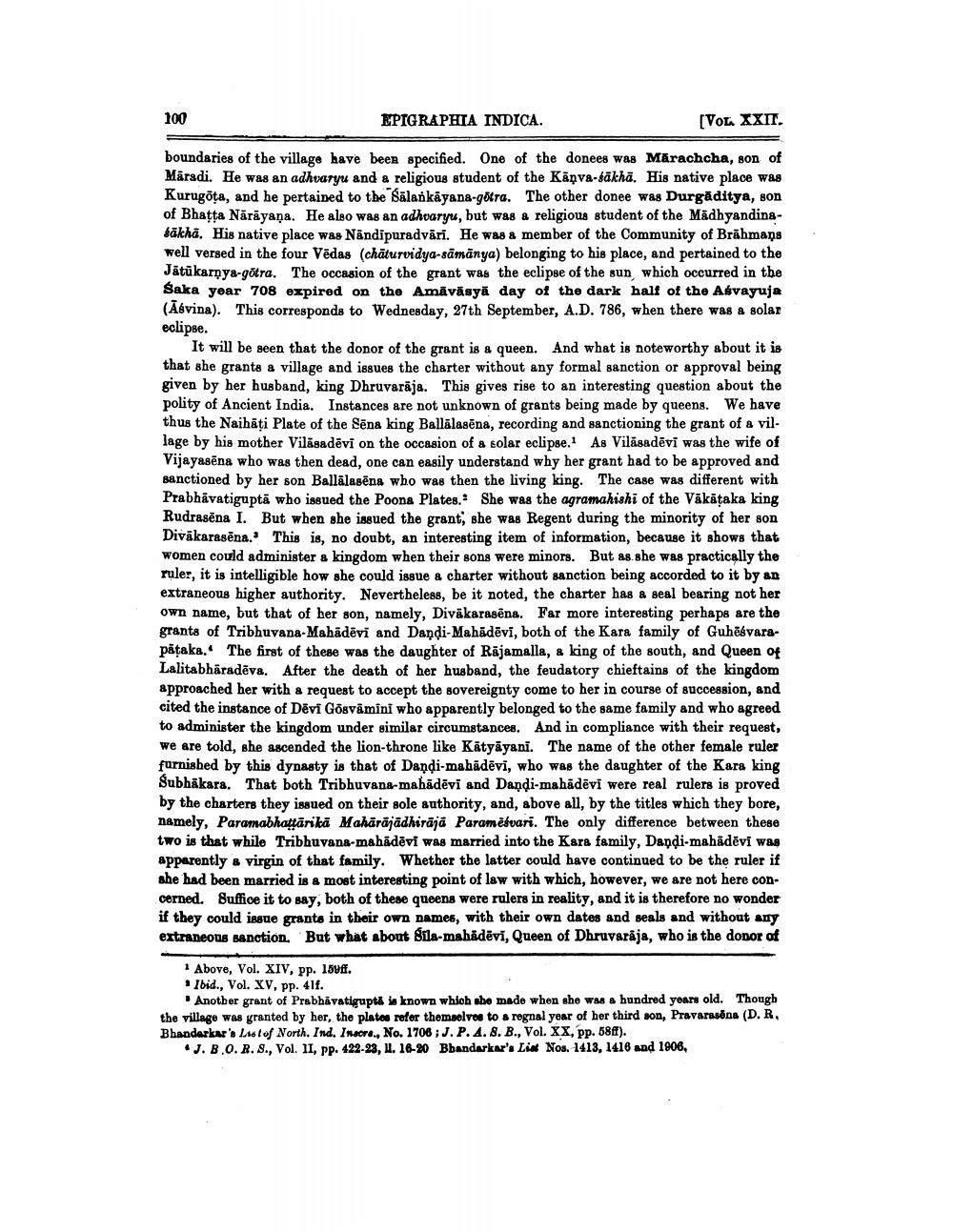________________
100
EPIGRAPHIA INDICA.
[VOL. XXII.
boundaries of the village have been specified. One of the donees was Marachcha, son of Maradi. He was an adhvaryu and a religious student of the Kāņva-śākhā. His native place was Kurugōta, and he pertained to the Salankayana-götra. The other donee was Durgāditya, son of Bhaṭṭa Nārāyaṇa. He also was an adhvaryu, but was a religious student of the Madhyandinaśākhā. His native place was Nandipuradvārī. He was a member of the Community of Brahmans well versed in the four Vedas (chaturvidya-sāmānya) belonging to his place, and pertained to the Jātukarṇya-gōtra. The occasion of the grant was the eclipse of the sun, which occurred in the Saka year 708 expired on the Amavasya day of the dark half of the Asvayuja (Aévina). This corresponds to Wednesday, 27th September, A.D. 786, when there was a solar eclipse.
It will be seen that the donor of the grant is a queen. And what is noteworthy about it is that she grants a village and issues the charter without any formal sanction or approval being given by her husband, king Dhruvaraja. This gives rise to an interesting question about the polity of Ancient India. Instances are not unknown of grants being made by queens. We have thus the Naihati Plate of the Sena king Ballalasēna, recording and sanctioning the grant of a village by his mother Vilasadevi on the occasion of a solar eclipse. As Viläsadevi was the wife of Vijayasena who was then dead, one can easily understand why her grant had to be approved and sanctioned by her son Ballalasena who was then the living king. The case was different with Prabhavatigupta who issued the Poona Plates. She was the agramahishi of the Vākāṭaka king Rudrasena I. But when she issued the grant, she was Regent during the minority of her son Divākarasēna. This is, no doubt, an interesting item of information, because it shows that women could administer a kingdom when their sons were minors. But as she was practically the ruler, it is intelligible how she could issue a charter without sanction being accorded to it by an extraneous higher authority. Nevertheless, be it noted, the charter has a seal bearing not her own name, but that of her son, namely, Divakarasēna. Far more interesting perhaps are the grants of Tribhuvana-Mahādēvi and Dandi-Mahādēvi, both of the Kara family of Guhesvarapāṭaka. The first of these was the daughter of Rajamalla, a king of the south, and Queen of Lalitabhāradeva. After the death of her husband, the feudatory chieftains of the kingdom approached her with a request to accept the sovereignty come to her in course of succession, and cited the instance of Devi Gōsvamini who apparently belonged to the same family and who agreed to administer the kingdom under similar circumstances. And in compliance with their request, we are told, she ascended the lion-throne like Katyayani. The name of the other female ruler furnished by this dynasty is that of Daṇḍi-mahādēvi, who was the daughter of the Kara king Subhakara. That both Tribhuvana-mahadevi and Dandi-mahadevi were real rulers is proved by the charters they issued on their sole authority, and, above all, by the titles which they bore, namely, Paramabhaṭṭārikā Mahārājādhirājā Paramēšvari. The only difference between these two is that while Tribhuvana-mahadevi was married into the Kara family, Dandi-mahadevi was apparently a virgin of that family. Whether the latter could have continued to be the ruler if she had been married is a most interesting point of law with which, however, we are not here concerned. Suffice it to say, both of these queens were rulers in reality, and it is therefore no wonder if they could issue grants in their own names, with their own dates and seals and without any extraneous sanction. But what about Sila-mahādēvi, Queen of Dhruvaraja, who is the donor of
1 Above, Vol. XIV, pp. 15vff. Ibid., Vol. XV, pp. 41f.
Another grant of Prabhavatigupta is known which she made when she was a hundred years old. Though the village was granted by her, the plates refer themselves to a regnal year of her third son, Pravarasana (D. R. Bhandarkar's List of North. Ind. Insers., No. 1706; J. P. A. 8. B., Vol. XX, pp. 58ff).
J. B.O. R. S., Vol. II, pp. 422-23, l. 16-20 Bhandarkar's List Nos. 1413, 1416 and 1906,




